 home coil info products ordering
home coil info products ordering
Loohan Communications Office
Orgone Technical Bulletin # 22
April, 2007
Using Radionics Devices in Orgone Warfare
[Note Jan., '08: I no longer make dial boxes, as I have found ways to accomplish optimum tuning automatically with hardware requiring much less space and less trouble. See OTB 28: Beyond Dial Boxes.]
April 22, '07: For Earth Day, I'll write a bit on radionics, as that is one way common people can help the Earth.
I myself am a novice who hasn't even read up much on the subject, but here are a few things that I believe I have established as true for myself when using radionics for warfare.
I thank those individuals who gave me much of this information.
1: Effective radionics depends on orgone power. Some people may be able to get results with a machine that has no orgone component, but I was not impressed personally.2: The more orgone power, the better, if you want faster results or take on big projects.3: One preferred way to achieve the orgone power is by having many resin-based units each with a mobius (or other continuous) coil, and hooking these all together in series. The more, the better.
Hence, there is little point in having a bunch of radionics boxes, as that will dilute your power. Ten mobius units in one series is a lot more powerful than two series of five units.
[Update 2019: I now consider the info I wrote in point 3 to be dubious at best.]4: There are two types of applications: continuous and short-duration.
Let's say you want to hit some insect pests in your garden with insecticide. Given a certain amount of orgone available, the ideal time to run this trend may be, say, four minutes. One can use intuition or dowsing to find the run time of any particular little project. Personally, I often have a feeling when it's done. Then one can clear off the unit and run something different.
But what if one wants to hit all insectile demons everywhere in all universes with anti-insectile demon energies? This is a long project. You will run the trend a while, the demons will attack you, you will incarcerate all you can, they will lick their wounds a while, then mount an intense, orchestrated attack, etc.
You might keep it up for weeks and months, and still have problems. But the whole time, the radionics box is sending them the damaging energy without losing effectiveness. You are just sending a freq. It could be any freq or several. [Update 2019: These days on a similar type of target I would likely find one freq used up after a spell, and a new freq would then be used for the same target.]
But the trend does not have to be a freq. It could be something like "ALL GREYS HAVE BEEN SUCKED INTO MY JAIL". This will set up a strong pull to help you round them up, and you can run that a long, long time, too.5: Hence, to me it makes sense to have one set of dials running most of my mobius units in series on a continuous trend, and have another unit or two for running other things, often short duration. These will have less orgone.
Of course, it is not required that all orgone devices used with a radionics box contain mobius coils, or be composed of orgonite. One can set various devices, crystals, etc. in contact with the mobius units to tie them into the loop. In the case of my SE-5, I don't even have any wires or coils added to it; I just place orgone units on the auxiliary input plate, and it works great.
May 1, '07: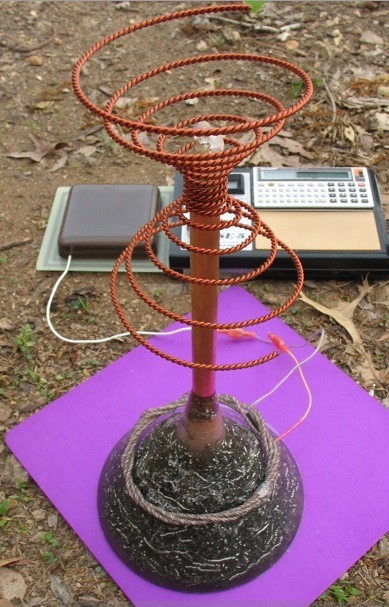 For that matter, one can connect together orgone units that have no actively driven coils with a single wire that is imbedded in each unit. One can drill a small hole in the mold before casting, and stick a flexible insulated wire in the hole, so that when you carefully cut the mold off later, the unit will have the wire sticking out. Tie the wire to something of metal inside the unit. This is more powerful than you might think, and one can thus link several units all together to work as one. 6: It is advantageous to have some units with 2 or more mobius coils. One can add an external one onto an existing unit. With 2 or more coils, it is advantageous to have some run by frequency pulsers (like the 555-timer based zapper units), and some run by the radionics box. This is even better than adding another mobe to the radionics circuit.
For that matter, one can connect together orgone units that have no actively driven coils with a single wire that is imbedded in each unit. One can drill a small hole in the mold before casting, and stick a flexible insulated wire in the hole, so that when you carefully cut the mold off later, the unit will have the wire sticking out. Tie the wire to something of metal inside the unit. This is more powerful than you might think, and one can thus link several units all together to work as one. 6: It is advantageous to have some units with 2 or more mobius coils. One can add an external one onto an existing unit. With 2 or more coils, it is advantageous to have some run by frequency pulsers (like the 555-timer based zapper units), and some run by the radionics box. This is even better than adding another mobe to the radionics circuit.
[Note: if this page does not display correctly, you are probably using FireFox -- the browser has bugs.]
On the right, there is a square orgone unit sitting on the extension plate of the SE-5. (In actual practice, I also stack more stuff on the square unit.) As it so happens, there are no coils in this square item, just some copper screen soldered to the end of the wire.
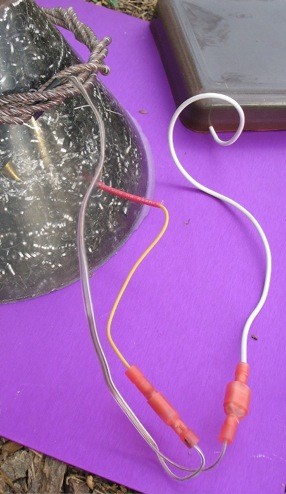 Let's take a closer look:
Let's take a closer look:
You can see a red wire coming out of the cone (which happens to be the antenna unit from OTB 20 re-cast with titanium and magnesium shavings). The wire changes to yellow further out. This is because the red thing is just a sleeve for re-inforcement. It is insulation I stripped off some 14g wire, and slipped over the thinner yellow wire.
Also note that I have added an external mobius coil.
Rather than hook the square unit directly to the antenna, I spliced in this mobius.
There is no complete circuit here. The SE-5 is not in metallic contact with the square unit. The extension plate of the SE-5 has a plastic surface. The single wire connection goes from the square unit through the auxiliary mobius coil and then into the antenna unit, where it goes through the spiral coil around the base of the copper pipe, then through an internal mobius coil, then is grounded to the copper pipe inside. Yet, it works really great, and the antenna will broadcast the SE-5 output quite strongly. I neglected to have the SE-5 working when I took the pics.
Incidentally, that is a 12x12" Tesla Purple Plate kindly donated by a reader. These are fairly decent.
This is just one way of doing things. Usually I have active mobius coils and a complete circuit, as that is necessary for electrical frequency pulsers. And for most radionics units I am likely to use, which have a 2-pole mono output jack.
Actually I pretty much stopped using the SE-5 for warfare. A simple dial box does just as good a job for that. Taking my own advice, I'm just running my dial box and freq pulsers. I put the above depicted orgone devices to work with that stuff when I'm not using the SE-5 for something. By placing one of my mobius units on top of the square jobby, I tie in the antenna to broadcast from the dial box.
It may be that an open circuit is superior to a closed one for antenna broadcasting. I haven't bothered to test it, but I dowse that if I were to complete the circuit by connecting another wire to the copper pipe, the broadcasting results would be inferior.
Also I get that existing units with exposed metal pipes, e.g. chembusters, can be retrofitted to act as open-circuit antennas with benefit. One way would be to drill a small hole in the copper, drive in a small screw, and tie the wire to it. Cover with tape to deter corrosion. Though if the pipes are open to the weather, electrolysis will eventually eat away the screw from the inside of the pipe.
May 5, '07: Tracking down a break in continuity in my closed-circuit radionics/orgone array, I realized that my 2nd hyperdisk (see OTB 20) lacks continuity. Which is interesting, as I soldered the connections. Oh, well. So I hooked both leads together up to my "open circuit" system that is contiguous with my closed circuit sytem, and it works a lot better!
May 6, '07: Actually, it was my 1st disk (I was confused because they were stacked one on the other) that had the fault, and it was not in the disk, but the plug end of the commercial patch cord was faulty! So I will put a new plug on it. But it goes to show, if you have a mobius unit with a break in continuity (I got one around here someplace) it can be salvaged by hooking it up to an open circuit.
I also have such a fault in my chem-buster base at the top of my property. I salvaged that one by taping a magnet to the wire ends as mentioned in my mobius page.
It also goes to show that it's a good idea to test your setup for continuity. It works OK even with a break, but it's much better without it.
May 8, '07: Revelation time! Today I did some more checking, and found that the rad box I got from Jon Goldman does not have continuity. Opening it up, I see that this is by design:

Those black things on the left are chassis jacks. That's what you plug your orgone devices into. And they each only have one lead going to them. In other words, this is not a closed circuit, either, but an open one. Only the tip of the plug connects to the box guts. That's the part to the right of the little black stripe. The return wire from the orgone device(s) just ends at the part to the left of the stripe. Which is not bad. But I think it would be better to run a lead from the other prong of the chassis jack to an antenna unit. This would give one an "open" orgone device at the terminus, instead of a mere wire. And I am developing a fondness for open devices, so why not take advantage of these wires going nowhere?
In other words, this is not a closed circuit, either, but an open one. Only the tip of the plug connects to the box guts. That's the part to the right of the little black stripe. The return wire from the orgone device(s) just ends at the part to the left of the stripe. Which is not bad. But I think it would be better to run a lead from the other prong of the chassis jack to an antenna unit. This would give one an "open" orgone device at the terminus, instead of a mere wire. And I am developing a fondness for open devices, so why not take advantage of these wires going nowhere?
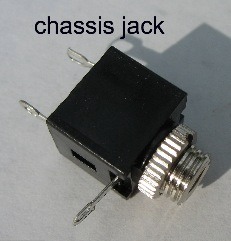 (Actually, chassis jacks have 3 prongs, as you can see in here. I do not know what the function is of the lower one, but a friend who seems to know about these things told me that if you want to hook up several chassis jacks together in series, you should short the 3rd prong to the one closest to it. So one could do that here, too.)
(Actually, chassis jacks have 3 prongs, as you can see in here. I do not know what the function is of the lower one, but a friend who seems to know about these things told me that if you want to hook up several chassis jacks together in series, you should short the 3rd prong to the one closest to it. So one could do that here, too.)
I reiterate that it is not substandard to have the wiring like Jon does. One can have all the open leads going nowhere that one wishes without harm, so long as there is continuity between the orgone devices themselves, connected to the box.
But wait, you say, wouldn't it be better to have 2 leads going to the output jack, and complete your circuits? Wouldn't that be more professional and thorough?
Another Jon (Logan) has some interesting pics and info about closed-circuit boxes here. Worth reading. But personally, I'm most interested in what works best, not what looks most professional. And I know Goldman makes real good radionics devices. And I dowse that Logan's boxes don't kick nearly as much ass.
Now I admit I'm a rookie at radionics stuff, but right now I'm most inclined to copy what Goldman does, with the modification of adding an additional wire output from each chassis jack to drive an "open" unit.
And I admit I don't understand the logic of Goldman's circuitry. The outputs on these pots are the center prongs. To use the device, I have to tune the one on the right first, then the middle one, then the left one. If I try it the other way, I get no stick-point.
So let's take a look at this: the output from the 1st pot goes to the left prong of the 2nd. The output of the 2nd also goes to the left prong of the 3rd. But does the output of the 3rd pot go to a chassis jack? No, it goes to the witness plate, then on to the left prong of the 1st pot. What does go to the jacks (the box's outputs)? Why, one is connected to the right prong of the 1st pot, and the other to the right prong of the 3rd pot. Which it shares with the lead from the stick-pad. Thoroughly confused? Well I am, but I can't even comprehend why pots and chassis jacks have 3 prongs instead of 2, that's how ignorant I am. But I figure Jon Goldman has studied and played with this stuff for years, so I'll just copy him.
How many pots should a device have? Goldman uses 3 per circuit [correction: he also makes some 6-dial circuits]. Some of his units have more than one circuit, meaning they are like several radionics boxes in one, I think). Three is definitely enough, from the standpoint of practicality. I don't feel a need for more, but, numerologically, I prefer 4. Also I get that there is something about 4 crystals, or steel plates, or anything "orgoney" when aligned in a straight line with proper spacing so that they resonate. Potentiometers are in themselves orgoney, that is, even without any wire connections they have significant intrinsic subtle energy for some reason. Merely by spacing 4 pots in a line, one "generates" orgone. So I plan to make something soon. Got myself a bunch of pots and knobs here.
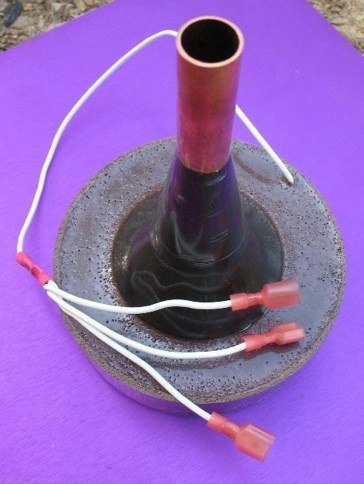 If one has a box like Goldman's, there is actually no need to have any orgone devices with 2 leads per coil. Or chassis jacks. One could just run the one wire out of each output from the box, and have all the orgone devices be "open".
If one has a box like Goldman's, there is actually no need to have any orgone devices with 2 leads per coil. Or chassis jacks. One could just run the one wire out of each output from the box, and have all the orgone devices be "open".
Here's my latest cute little butt-kicker. It has a mobius coil with one end soldered to the base of the pipe. As you can see, by simply splicing more leads in, I create more connections for more such devices. And with this uni-wire, "open" method, it is no problem if some of the connectors aren't connected to anything.
Of course, if you want to run electrified freqs through coils, you do need a complete loop.
Someday I may end up running most of my present devices on freq pulsers, and have mostly open style units on my rad box.
May 10, '07: Mr. Goldman says about the wiringIf you look closely it's like a circle pattern inside with branches, everything is in series even the witness plate.
There is only one plate in that design so it works for both energy input (trend) and energy receiving (target). A 2 plate system is wired a little different, also if it has an amplifier module inside it would be wired a little different as well and would also include of course a transmitting antenna in the loop.
Yeah, there are systems where you put the target, e.g. the written name of the target, a pic, a DNA sample, on one plate (or in one bowl), and the trend, e.g. what you want to have happen, or a medication, or an energy symbol, on the other plate. Is this superior? I don't know.
Jon Goldman also says
With a Rad box it should all flow together. It should have a psychotronic energy flow. The easiest and best way to do this is have the dials (pots) in series and then connect your plates as the energy intake and energy receiving, and then a stick plate if you want.
Make of that what you will. Also, regarding amplifier modules (I discussed these some in OTB 20) he gave more detail on how to hook one up to a dial circuit:What I do is, if you have a 3 or 6 pots machine, the last pot (number 3 pot or number 6 pot) output (middle connector) goes into the amps input, that way the signal is amped up, then I like to have the output (speaker lead) of the amp go to the energy receiving plate (Target) and also if there is an antenna involved to the antenna also, so both would be wired to the output of the amp. It works great.
* * * *
A reader emailed me some basic questions, and I thought I'd answer here. And maybe ramble on a bit.
There are numerous ways to strike a target with energy. One can take a simple mobius device like the Succor Punch (mobe-wrapped crystal) or (more complex) a Power Wand, and "shoot" the target. Personally, I don't try to aim it at the target (unless it is very close). I think it is generally more effective to imagine the crystal or whatever as being inside the target or vise-versa, rather than imagine a beam going through space and smiting the target.
One can also use a PC. There is a connection between the mouse and the cursor. One can put the cursor on a target and place the weapon on the mouse or mouse cord. This gets the energy to the target. Good with maps.
Of course, you might be wanting to do something more specific than just sending a big blast of positive energy. Thus people have made wands with compartments for putting in small amounts of cleansing herbs and whatnot. Or you could write a trend on a piece of paper and stuff it in. Point at the target. If a remote target, I would envision it in my space and poke it.
But guess what? You can also sit down in your recliner and mentally tell some orgone device or big crystal sitting several feet away to send a particular trend to a target. Until you clear off that command, it will continue to do that indefinitely.
So what is the advantage of fancy radionics equipment? Well, for one thing, by working with energy and Intrinsic Data Fields, you educate yourself on how your mind can interact with the universe, and take advantage of natural law.
Why, with some fancy machines, one can make all the homeopathic and flower remedies one wants, or send their energies to a chosen target. Ain't that amazing? They must have incredibly advanced and sophisticated circuitry in there to be able to generate such delicate frequencies, don't you think? I doubt it. I'm pretty sure one could use a 2-plate rad box, put lactose pills on the target plate, write "plutonium 100C" on a piece of paper, put it on the trend plate, set the dials, and after a few minutes have the remedy. If one has a clean space with no energy interference.
Incidentally, I always put my paper witnesses face down on the plate, because energy issues upwards from written words and pics. Since I'm a stickler for milking every drop of orgone, I even make sure I write on the yang side of the paper.
One could just hook up several mobius devices together with no rad box, yet the orgone energy will amplify one's intent if one merely tells the setup to do a certain energy task. Actually one can do that with a single "Holy Hand Grenade" or charged crystal, with less power.
I don't need a stick pad, and don't even really need a witness plate as such. I could have a "witness crystal" or "witness orgone block" and just mentally put my intentions into it (clear previous intentions first). But the dials, now those I can appreciate. I couldn't tell you why adjusting the resistance in a non-electrified wire locks the orgone onto one's intent so well, but that's what it does.
I have been thinking in terms of building a unified device, basically an orgone device with dials to tune it. The main crystal would serve as the witness "plate". There could be a trend input bowl. No stick-pad.
One thing I noticed with radionics+orgone devices is that they dowse as "sending" energy long after they have been taken off a target. It's like the thought-form is timeless. In fact I have been told that one does not want to overdo it; just a few minutes are required for most trends.
And this phenomenon is not limited to dial boxes; I am still "sending" stuff with the amp unit that I blew up weeks ago. But can one get this effect with, say, a Succor Punch or Power Wand? Come to think of it, I don't think this normally occurs. Maybe radionics tech is necessary for stable thought-forms.
One interesting thing about this. A few weeks ago I was using my SE-5 to send certain freqs into curing epoxy. While I was at it, I sent those freqs to my charging stand that I cure units on, and the big orgone units inside that. Well, after I did that a while, I realized that I no longer needed to run the radionics machine to lock those freqs into curing devices. Because the water in the tiny bottles inside those big 2-year-old units inside the stand is holding that info like a hard drive. As is the quartz. I don't think the epoxy is, because it was well-cured already. So all I have to do is remember to mentally lock those devices onto the items I'm casting, and have them lock the programming into the new devices. Seems to work 100%. But only if I remember.
For that matter, I can sic these old units on any target I want, and have them hammer it with the programmed (disgustingly positive) frequencies.
Of course, it is ideal to program tools when the resin is still soft, as then you can really lock stuff in. Even a simple device becomes a radionics-like unit if you lock in a trend really good. Then to use, you mentally shift it from target to target and tell it to impart the trend.
Another interesting thing is that one can conjure up virtual radionics machines with massive orgone devices, mentally put on the target and trend and tweak the dials. Tell the unit to wink out of existence at the right time. This is surprisingly effective.
May 11, '07: I started putting together an 8-dial unit. Yes, I wanted to see if there was anything to this beaucoup dials business. I learned one thing already:  I bought the wrong kind of pots. That is, instead of having little loops on the terminals to tie the wire to, they have prongs for mounting on a board. So I'm going to have to get some of these "ring connectors" to put on my wire ends before I can proceed.
I bought the wrong kind of pots. That is, instead of having little loops on the terminals to tie the wire to, they have prongs for mounting on a board. So I'm going to have to get some of these "ring connectors" to put on my wire ends before I can proceed.
On second thought, it appears they aren't available in a small enough size. So I'll have to form loops in the ends of my wires.
May 15, '07: This was not so tough to do, it turns out.

I wound the ends of the wires around a 1/16" drill bit, slid them over the pegs, and squished them on with needle nose pliers.
I put the 8-dial project on hold. This is a box I bought some tienchi ginseng in back around the turn of the century. Let me explain a few things:
I asked Jon how to hook up the wires if one wants separate plates for trend and target. If you look up at the pic of his beige box, you will see that a wire comes out of the output of the last pot, to the witness plate, then from the plate to the left input of the 1st pot. Well, if you have 2 plates, it's the same thing, except that the wire from the last pot dead-ends in the target plate, and the wire starting in the trend plate goes to the first pot. Logical enough: trend ---> input, output ---> target.
But I spaced out and put 2 leads in each plate, so I have the extra wires (1 black, 1 white) going nowhere right now. Someday I may want to hook up auxiliary inputs or outputs with those.
I dutifully connected extra white output wires from the chassis jacks. And stop snickering about my soldering ineptness!
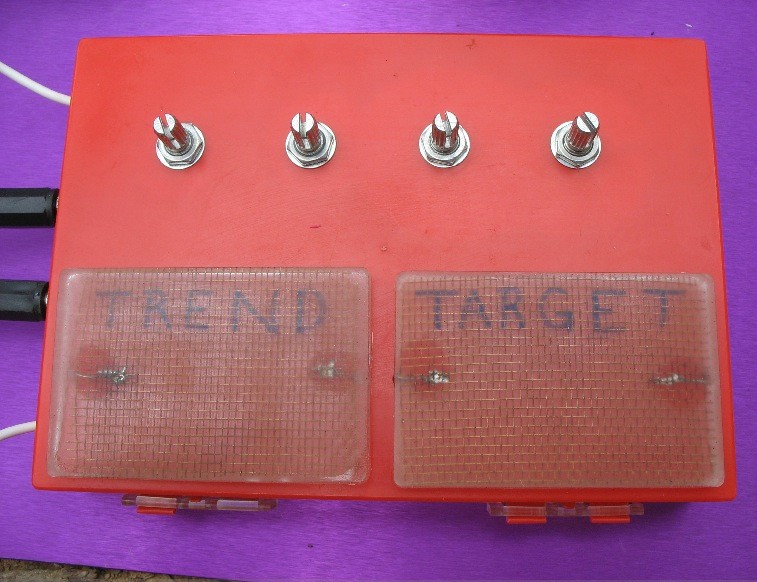
No dials yet; the ones I bought are too large to permit close spacing. I put the pots on 1.25" centers, though larger spans are OK, too.
The plates are just thin little things of clear epoxy with copper screen embedded in them. I got a roll of this screen at a yard sale in '95. It seems to work about as well as mobius coils for picking up energy. I soldered the leads, and used glue to attach the plates.
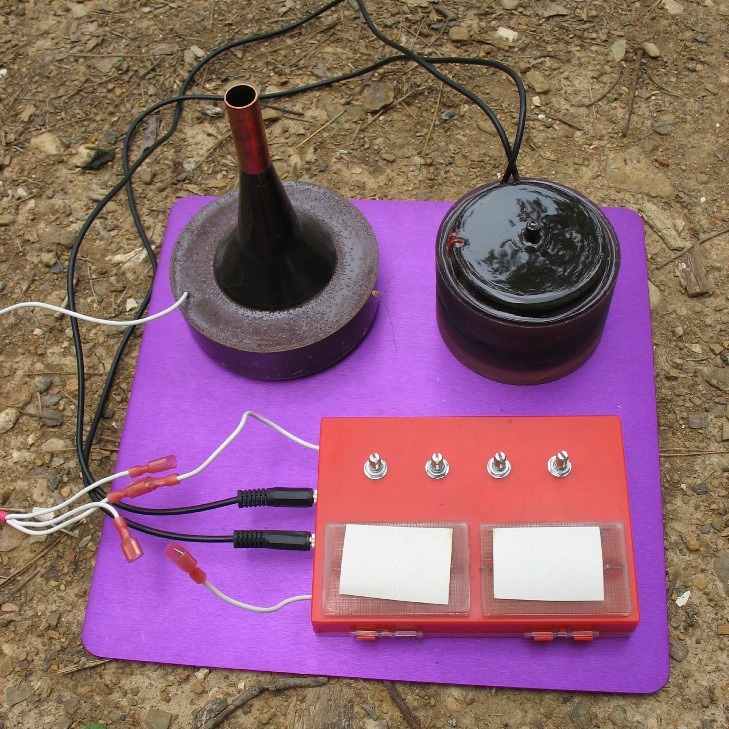
Here it is driving a couple units. Note that I did not plug the spare white lead to a spare one from the orgone antenna unit; that would have created a short-circuit that probably would not be desirable.
Later, I unplugged the beige box driving my massive orgone setup indoors, and replaced it with this red box. It seems to work fine.
May 29, '07: Here's something that may be a hot tip, though I'm not sure how workable it is in an urban area with lots of stray electricity and noise in the ground. But I'm like 600' from the nearest grid house here. And got loads of orgonite, etc. planted all over to keep things clean.
What I did is run a lead from my circuit that interconnects the orgone devices/radbox, to the ground jack in my wall socket.
My amateur, non-code ground (rebar I hammered into the clay dirt) outside is only a few feet deep, I forget how much, maybe 3-4'.
The rebar seemed to be vibrating to the rad freq, yet it didn't seem to drain or muffle this desired energy. Then I used my intent to tell it to drain any undesirable energies. I got this idea from Jon Goldman. (He used a water pipe to drain negative energy from an audio amp rad box.)
Soon as I did that, the DOR vibe in the rebar got real strong. Now my orgone devices connected to the radbox don't seem to be processing DOR; they just shunt it outside, leaving them free to just enforce my dictates. But my orgonite outside is working hard.
June 7, '07: I did get some knobs for my little box. Those knurled pots do work without knobs, but it is better to have them, because the larger the diameter of the knob, the easier it is to adjust with more sensitivity. Here I have some relatively small knobs.
I did get some knobs for my little box. Those knurled pots do work without knobs, but it is better to have them, because the larger the diameter of the knob, the easier it is to adjust with more sensitivity. Here I have some relatively small knobs.
So I decided to make myself a luxury dial box with larger knobs.
The flange with the numbers on these knobs has no particular advantage over a simple pointer that I'm aware of, but they are very handsome knobs and inexpensive (goldmine-elec.com has them).
Jon had supplied me with a nice empty project box. As well as info on where to get the knobs. You have to have "knurled" pots to use these. These come with various shaft diameters, but apparently all are usable because you widen the split in the shaft with a screwdriver until it expands enough.
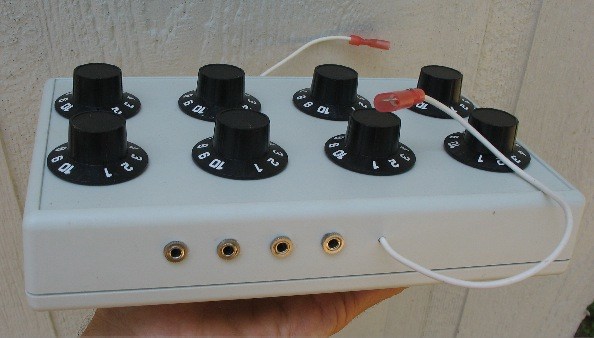 By paying attention to numbers and spacing, I made a box that is somewhat of an orgone device in itself.
By paying attention to numbers and spacing, I made a box that is somewhat of an orgone device in itself.
Those jacks are all output jacks in series. One nice thing about chassis jacks is that when empty, they close the circuit.
The far white wire is for input (trend). The nearby one is, of course, that straggler from the last jack put to good use.

The guts:

I wired it a bit differently from the Goldman box (which I sent on to a friend who has loads of powerful mobius devices and pulsers, but had no box -- his warrior clout has gone way up now). I can always add the other leads if I want, but I had the impression this would be just as good, if not a wee tad better. I wired all the outputs in series from the output of the last pot.
Someday I will probably try plugging an amp unit into the 1st jack.
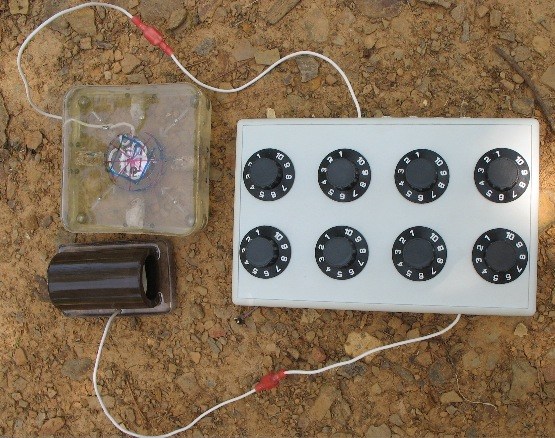 Here it is in operation. There is a certain logic: the 1st knob is by the input wire, then the sequence for adjusting them goes clockwise until it gets to the last pot which is near the 1st output jack.
Here it is in operation. There is a certain logic: the 1st knob is by the input wire, then the sequence for adjusting them goes clockwise until it gets to the last pot which is near the 1st output jack.
Since I didn't want to waste valuable space on my project box for mere witness plates, I am forced to have them as peripherals. That weird clear-cast square unit is my "targetter". It does not radiate much orgone, but concentrates the output signal into the target plate. The target is placed there mentally. One advantage of not having a written target is that the target can be added to or switched remotely. Tentatively, I have the impression that this does not upset the dial settings. Changing the trend does upset the dial settings.
So I might be miles away, and decide to address another malefactor with the same trend, and all I have to do is mentally adjust the target plate.
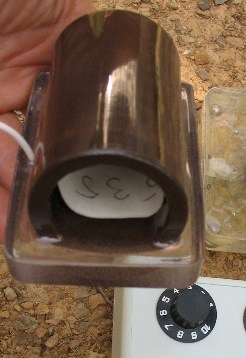 I love my trend module. The cylinder is cast orgonite with copper screen embedded for pickup.
I love my trend module. The cylinder is cast orgonite with copper screen embedded for pickup.
An ordinary metal plate or bowl does work fine, but this unit has several minor advantages including especially that it contains the witness in a neat manner, be it paper, a substance, a programmed crystal, whatever, even if the unit is in motion. I plan to incorporate it inside a plastic case with other components so it can be used on road trips.
With a cylindrical witness bowl, it makes no difference which side of the paper you write on. I wrote on both sides of this one.
So how well does the unit work? Very well. The additional and larger knobs make it a bit easier to adjust with greater precision. The wiring method seems fine. Right now I have a couple additional orgone weapons plugged in, and am running a completely different trend from what the bulk of my other stuff is running. In a different location -- orgone devices, especially with coils, etc. will tend to get entrained by other devices nearby.
So I have most of my stuff right now blasting the evil Lyrans with doom and misery, whereas my new unit is running other devices sending the same perps 1535 Hz, Total Personal Responsibility, Love, and Kindness (explanatory thread). I like to cover all my bases. It does seem to freak out the bad guys.
I thought of something I forgot to do with my new system: tomorrow I'll splice in a ground wire on the line between the trend module and the box.
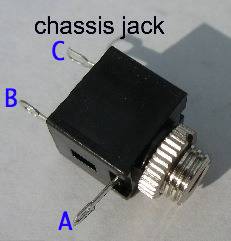 July 24, '07: Chassis jacks demystified. Your intrepid investigator has actually gone so far as to slap a continuity tester on one of these, and come to the following conclusions:When no plug is in the jack, there is continuity between B and C.When a plug is in the jack, there is no continuity between terminals, but one of the input leads to the plug (the one that will be on the periphery just under the outer insulation in a standard patch cord) is continuous with the A terminal.
July 24, '07: Chassis jacks demystified. Your intrepid investigator has actually gone so far as to slap a continuity tester on one of these, and come to the following conclusions:When no plug is in the jack, there is continuity between B and C.When a plug is in the jack, there is no continuity between terminals, but one of the input leads to the plug (the one that will be on the periphery just under the outer insulation in a standard patch cord) is continuous with the A terminal.
And the other lead (the core wire in a patch cord) is continuous with the C terminal. (The convention seems to be to have the outer wire be negative and the core wire to be +.)The A terminal is also always continuous with the the metal threads. This is important only if one is mounting the jack on a conductive surface.
So one can see that if one wanted the circuit to be broken when the plug is removed, one would neglect to use the B terminal at all. If one wanted the circuit to continue on past the jack when the plug is removed, one would connect the A and B terminals together. This is what I've always done so far. And possibly all most of us will ever need to know about the subject.
But another possible application (which may come in handy for something someday) would be to make it so that by plugging something in, one breaks one circuit to supersede it with something else. That is, in circuit #1, one lead would connect to B and one to C, thus conducting the electricity or whatever past the jack. But a different wire would connect to A, meaning that when you plug something in, instead of whatever feeds into B going on to wherever C leads to, that circuit would break, and instead, whatever you have soldered to A will be continuous with the outer wire of the input cord, which could eventually feed back into the jack via the core cord wire and then through the C terminal and on.
 Jan. 6, '08: Where I have used this is when I put an internal battery in something, yet want to bypass that battery when I plug in an external power source.
Jan. 6, '08: Where I have used this is when I put an internal battery in something, yet want to bypass that battery when I plug in an external power source.
Here's how to do that.
Oops, on second thought, I kind of screwed that up. If you do it that way, you will end up with a polarity that is the reverse of the convention, and whatever you plug in will have to match that. You might prefer to reverse the + & - depicted.

See also OTB 28: Beyond Dial Boxes
Loohan
next OTB
For that matter, one can connect together orgone units that have no actively driven coils with a single wire that is imbedded in each unit. One can drill a small hole in the mold before casting, and stick a flexible insulated wire in the hole, so that when you carefully cut the mold off later, the unit will have the wire sticking out. Tie the wire to something of metal inside the unit. This is more powerful than you might think, and one can thus link several units all together to work as one.
Let's take a closer look:
In other words, this is not a closed circuit, either, but an open one. Only the tip of the plug connects to the box guts. That's the part to the right of the little black stripe. The return wire from the orgone device(s) just ends at the part to the left of the stripe. Which is not bad. But I think it would be better to run a lead from the other prong of the chassis jack to an antenna unit. This would give one an "open" orgone device at the terminus, instead of a mere wire. And I am developing a fondness for open devices, so why not take advantage of these wires going nowhere?
(Actually, chassis jacks have 3 prongs, as you can see in here. I do not know what the function is of the lower one, but a friend who seems to know about these things told me that if you want to hook up several chassis jacks together in series, you should short the 3rd prong to the one closest to it. So one could do that here, too.)
If one has a box like Goldman's, there is actually no need to have any orgone devices with 2 leads per coil. Or chassis jacks. One could just run the one wire out of each output from the box, and have all the orgone devices be "open".
I bought the wrong kind of pots. That is, instead of having little loops on the terminals to tie the wire to, they have prongs for mounting on a board. So I'm going to have to get some of these "ring connectors" to put on my wire ends before I can proceed.
I did get some knobs for my little box. Those knurled pots do work without knobs, but it is better to have them, because the larger the diameter of the knob, the easier it is to adjust with more sensitivity. Here I have some relatively small knobs.
By paying attention to numbers and spacing, I made a box that is somewhat of an orgone device in itself.
Here it is in operation. There is a certain logic: the 1st knob is by the input wire, then the sequence for adjusting them goes clockwise until it gets to the last pot which is near the 1st output jack.
I love my trend module. The cylinder is cast orgonite with copper screen embedded for pickup.
July 24, '07: Chassis jacks demystified. Your intrepid investigator has actually gone so far as to slap a continuity tester on one of these, and come to the following conclusions:
Jan. 6, '08: Where I have used this is when I put an internal battery in something, yet want to bypass that battery when I plug in an external power source.
 home coil info products ordering
home coil info products ordering



